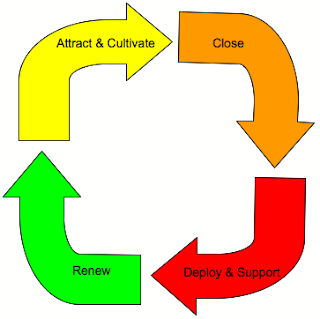Product managers are instructed to use the information gathered in these discussions to become the authority within their company on what the market needs. They equip themselves to be "prospect" experts, not just "product" experts, and use their expertise to guide product development and marketing strategy.
Product managers with on-premise solutions need to consciously establish this routine of systematically gathering market input. And the best of them do it well, diligently carving out time on their calendars to meet with customers and prospects on-site, at trade shows, and user groups.
The sales and marketing for on-premise applications is essentially a straight-line process - running from "attract & cultivate qualified prospects," to "closing deals," to "deploying and supporting the application." Gathering useful input from customers and prospects requires that product managers establish an effective feedback loop themselves.

On-premise solutions follow a straight-line process, and product managers must establish a feedback mechanism themselves
SaaS Provides an Automatic Feedback Loop
In the SaaS world, this feedback process is built right into the model. Product managers automatically get input from every single customer every single day. They can see precisely how customers are using the product, when they're using the product, and where they're running into difficulty. They have access to hundreds of useful data points from hundreds or thousands of customers.
Unlike the straight-line process of the on-premise model, under which product managers must establish the feedback mechanism themselves, the feedback loop is built right into the SaaS model. All current customers are prospects too and enhancing the solution to meet their requirements is essential to securing renewals. And SaaS companies require high renewals to succeed.

SaaS solutions provide a built-in feedback mechanism
Companies that have made the transition from on-premise to SaaS models will tell you that one of the primary advantages they've gained is their ability to better understand their customers. They use this knowledge to set smarter product development priorities and develop more effective sales and marketing strategies. (See "Taking Advantage of Customer Satisfaction Information.")
The automatic feedback loop, built into the SaaS model, gives product managers a window directly into customer and prospect behavior. They should take advantage of that window and watch what customers are doing. As Yogi Berra would explain: "You can observe a lot just by watching."